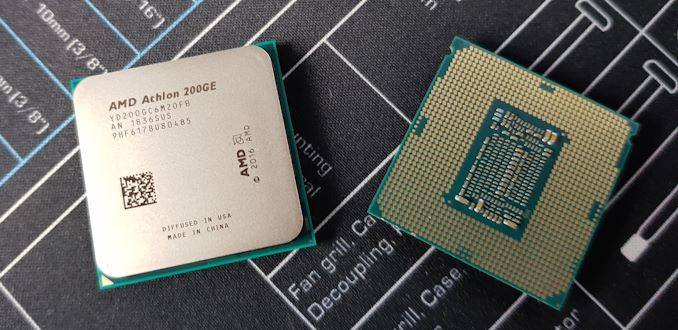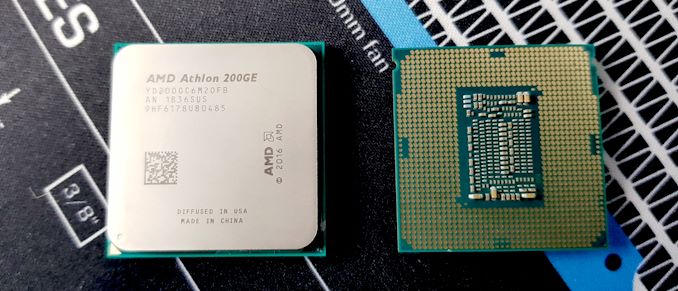The $60 CPU Question: AMD Athlon 200GE or Intel Pentium Gold G5400? A Review
by Ian Cutress on January 14, 2019 8:00 AM EST
In the course of our reviews, when we get a chance to get hands on with random processors, we run our test suite and add the data to our database. Sometimes that doesn’t materialize directly into a review, but at least we have the data. Two very similar CPUs have come across my desk recently: AMD’s dual core Athlon 200GE, and Intel’s Pentium G5400. Both chips round to the $60 mark, have some form of integrated graphics, and are aimed at budget systems.
This is going to be fun
One of the perennial issues with modern technology review cycles is that there’s a lot of focus on the high-end parts. These are the ones that the manufacturers sample: they have the highest margins, but are also the halo products: if they sit atop of the standings, then the hope is that that influence will trickle down into the rest of the product range, typically the high-volume parts. There is also the added benefit that more people want to hear about the best of the best. It’s a reason why there are so many Ferrari and Aston Martin ‘WOW’ pieces in written and video media.
Normally this would make sampling very difficult. If we were reviewing cars, anyway. The two chips in today’s analysis, the Intel Pentium Gold G5400 and the AMD Athlon 200GE, cost around $60 apiece, which I forked out for personally as I was never expecting to be sampled. (AMD asked if I wanted a 200GE sample two days after my retail unit arrived, go figure. I sent that on to Gavin for his 7-year old’s new gaming system.)
| AMD vs Intel at ~$60 | ||
| AMD Athlon 200GE |
Intel Pentium Gold G5400 |
|
| Cores / Threads | 2 / 4 | 2 / 4 |
| Microarchitecture | Zen | Coffee Lake |
| Motherboards | X470, X370, B450 B350, A320, A300 |
Z390, Z370, Q370 H370, B360, H310 |
| CPU Frequency | 3.2 GHz | 3.7 GHz |
| L2 Cache | 512 KB/core | 256 KB/core |
| L3 Cache | 2 MB / core | 2 MB / core |
| Integrated Graphics | Vega 3 192 SPs |
UHD 610 12 EUs (96 ALUs) |
| DDR4 Support | DDR4-2933 | DDR4-2666 |
| GPU Frequency | Up to 1000 MHz | 350-1050 MHz |
| TDP | 35 W | 54 W (2-core die version) 58 W (4-core die version)* |
| Price | $55 (SRP) | $64 (1k/u) |
| * Intel harvests both 2+2 and 4+2 dies to make G5400 parts. It's impossible to know which one you have without removing the lid and measuring the die area. | ||
When we stack up the two processors side by side, it gets interesting. Both are dual core, quad thread parts. The Intel processor has the frequency advantage, running at 3.7 GHz compared to the 3.2 GHz of AMD, but the AMD has beefier Vega 3 integrated graphics compared to the UHD 610 (GT1) graphics of the Intel chip. One sore point might be the TDP, where the AMD chip has a rating of 35W and the Intel chip is rated at 58W, however as we’ll see in the review, neither of them come close to those values.
Tackling the budget end of the market is fun. I’ve been a long-time advocate for budget builders to build a system piece-by-piece, getting one high-end part at a time rather than smearing a budget across several average parts at once. Under this philosophy, these processors could very well be the start of one of those builds, only costing an average of $60 MSRP. Note that under this philosophy, you might end up with that big graphics card before a processor that can power it. We’re covering those benchmarks as well.
Before you click further, place your bets on who you think will win: the Intel Pentium Gold G5400, or the AMD Athlon 200GE?
Latest News: While neither processor is officially overclockable, since we tested for this article it was recently reported that MSI motherboards with certain BIOS versions will allow users to overclock the 200GE to ~3.9 GHz. I've asked Gavin to contribute, and he managed a nice 3.9 GHz over the 3.2 GHz base clock. Head over to page 21 for the details.
Pages In This Review
- Analysis and Competition
- Test Bed and Setup
- 2018 and 2019 Benchmark Suite
- CPU Performance: System Tests
- CPU Performance: Rendering Tests
- CPU Performance: Office Tests
- CPU Performance: Encoding Tests
- CPU Performance: Legacy Tests
- Gaming: Integrated Graphics
- Gaming: World of Tanks enCore
- Gaming: Final Fantasy XV
- Gaming: Shadow of War
- Gaming: Civilization 6
- Gaming: Ashes Classic
- Gaming: Strange Brigade
- Gaming: Grand Theft Auto V
- Gaming: Far Cry 5
- Gaming: Shadow of the Tomb Raider
- Gaming: F1 2018
- Power Consumption
- Overclocking
- Conclusions and Final Words











95 Comments
View All Comments
mczak - Monday, January 14, 2019 - link
Yes, I'd expect at least the Athlon to be quite close to its TDP with simultaneous CPU+IGP load.The Pentium probably not really (although the Pentium G5500/G5600 could get close, as these have the GT2 (UHD 630) rather than the GT1 (UHD 610) graphics, which also should be much more competitive with the Athlon).
biiiipy - Monday, January 14, 2019 - link
In my country the cheapest I can find is 200GE for 50€ andG5400 for 90€... yeah...ET - Monday, January 14, 2019 - link
Very nice to see a low end comparison, and a quite comprehensive one at that.What I don't understand is why quite a few benchmarks (especially on the IGP tests) are missing some of the CPUs.
Rudde - Monday, January 14, 2019 - link
The test setup table doesn't include the G5400.shabby - Monday, January 14, 2019 - link
The g5400 is $183 on amazon...T1beriu - Monday, January 14, 2019 - link
You should have measured the power consumption for 100% CPU load + 100% GPU load, lile POV + Furmark?Flunk - Monday, January 14, 2019 - link
These are close enough that I would buy whichever I could get cheaper (with a compatible board of course).Targon - Monday, January 14, 2019 - link
Of course, if you are looking to start low but then upgrade later, socket AM4 will allow upgrades from the lowest end to top end.edzieba - Tuesday, January 15, 2019 - link
So could the Pentium, right to the 9900k.eastcoast_pete - Monday, January 14, 2019 - link
@Ian: thanks, and I agree with your conclusion, but only if the ~$60 mark is a hard upper limit. Take-home for me: if you believe that you're going to be working and gaming on the iGPU of the chip even for a few months, try as hard as you can to get the extra $40 and buy the Ryzen 2200 G instead, which retails for $99 or so. That is still the value king here, and by a big margin. Unlike either the Pentium or the Athlon, the 4 cores and the (much beefier) iGPU of the 2200G can provide the 25-30 frames/second in many of the games tested here, has generally superior performance on non-gaming applications as well, and, once the dedicated graphics card arrives, it still gives a better showing than either Athlon or Pentium. Plus, as Gavin here and others on their sites have shown, there is significant headroom left for overclocking if that extra 10% or so is a must-have. So, long in short: For a budget system, and if at all possible, get the Ryzen 2200G. It is well worth the 40 bucks more.